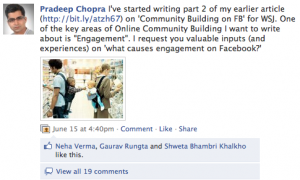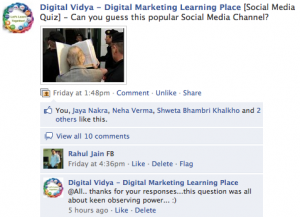Communicating the presence of your company Facebook page and keeping users or readers engaged is a second important part of building a company page on Facebook. I had written last week about developing a strategy and an execution plan as a first step. After you’ve identified your community-building objectives and the target audience, the key question to answer is: “What’s in it for them?†The success of your efforts to promote your Facebook page resides in having answers for these questions: Why will a person join your community? And why will that person participate in the community on an ongoing basis?

Which brings us to the fundamental question: “What causes engagement on Facebook?â€
The answer is central to the phenomenon of community-building across social media platforms.
To answer this question, I thought of using the power of community, by posing this question to people in my Facebook network. The result was some valuable consumer insights into the content that users look forward to.
These were some top categories:
- Contests and giveaways
- Quizzes, surveys, polls, requests for feedback so every relevant question attracts an answer (i.e. engagement)
- Humor, jokes and trivia
- Controversy or debate
- Patriotism (especially in countries like India and Japan)
- Real-life stories or examples
- Breaking news
- Unexpected information
- Interesting pictures and videos;Â in the U.S. and other developed nations, where Internet bandwidth is not an issue videos are viewed even more than pictures
Drawing from the above, I would say that “relevant, interesting and easy to consume†content always draws engagement. However, the process of identifying the relevant content isn’t always logical. For example, at our digital marketing learning community on Facebook, we’ve seen that Digital Media Cartoons and Jokes, which have no direct relevance to “learning,†are among the most engaging content.
Digital Media Cartoons and Jokes
Chip and Dan Heath have captured all of the above distinctions very well in the “SUCCESs†model in their highly popular book “Made to Stick.†According to the “SUCCESs†model, any idea (or content) which has the following traits in it causes stickiness (or engagement): Simple, Unexpected, Concrete, Credible, Emotional, Stories.
I’ve seen this model working amazingly well for any form of communication (Facebook wall post, Tweet, post, a proposal, or a business presentation) on any medium (online as well offline.)
Interestingly, you don’t need to create all of the content you would want to publish in your community. For almost every business vertical, there is an abundant amount of free and readily available content across various digital avenues such as search engines, blogs, video channels (e.g. YouTube), document channels (e.g. SlideShare), photo channels (e.g. Flickr), discussion groups (e.g. Google Groups), Twitter search, Wikipedia etc., which you can aggregate in a useful and copyright friendly way for your audience.
The best part is you don’t need to search for this content. It can come to your mailbox if you use smart tools such as Google Alerts or SocialOomph (a keyword alert tool.) Further, using tools and applications (such as SocialRSS), you can automatically republish your content from other channels (e.g. a blog post or a tweet) to your Facebook fan page.
The process so far will ensure that you’ve laid an extremely solid foundation to build a live and engaging community. Your job then is to scale up and you can use some of the promotional opportunities below:
- Facebook advertising: This is one of the most powerful and least understood and explored opportunities to build a critical mass for your community. We’ve used it for over 20 communities on Facebook and it has helped us acquire relevant fans on Facebook for as low as one U.S. cent per fan.
- Facebook applications: There are numerous freely available Facebook applications such as Poll, which allow you to continuously engage your audience and encourage them to promote your community within their network.
- Integration with other digital channels: You can embed your Facebook Fan Page Box or a widget in your website or blog. Similarly, you can promote your Facebook community through a presentation on SlideShare, YouTube, and Email signature, or through a tweet.
- Leveraging offline channels: Inviting the target audience to join the community by publishing the link of your Facebook community on a business card, restaurant menu, billboard, print ad, or product packaging is increasingly becoming a trend even in India.
- Search engine optimization: With the inclusion of Facebook fan pages in search engine results by all major search engines (Google, Yahoo and MSN), you can optimize your fan page to attract more community members. The rules of optimizing a Facebook page are similar to the rules of optimizing a web page. The common elements of SEO such as inclusion of keywords in the page content and URL and incoming links from other relevant sites should be continuously leveraged to generate organic growth.
In the next post I will explore the metrics or consumer signals that you must regularly track.
This article was originally published at WSJ’s India Chief Mentor.
- The Future of Search (Wall Street Journal) - October 6, 2010
- The ‘Cost’ of Facebook Marketing (Wall Street Journal) - July 15, 2010
- Tracking Your Company Facebook Page (Wall Street Journal) - July 9, 2010



Thanks Melvin for liking this post.
Yes, I spend lot of my personal time along with support from other team mates on our community on Facebook. Here are the key reasons for our community growth on Facebook:
a.) Quality Content: Nothing is more important than content and that’s what has brought us majority of fans.
b.) As part of our bootcamps, we regularly connect with people interested in Digital Marketing/Social Media and that segment is one of the most relevant segments for us.
c.) Facebook Ads is also a small contribution
d.) We’ve done only 2 contests and I don’t think we’ve got any big jump in growth of fans due to these
e.) Rest of Resources: From our website, through email signatures, visiting cards, other Social Media Channels (LinkedIn, Twitter etc) collectively contributes to the growth
Hope this helps! Let me know if you have any other query.
wow, excellent post here Pradeep 😉
Some questions.
1) Are you the Community Manager for Digital Vidya – Digital Marketing Learning Place?
2) How did u manage to grow your Fanpage to 11,000? Did u run many contests? or just Ads?
-Melvin
thesocialjuice.com